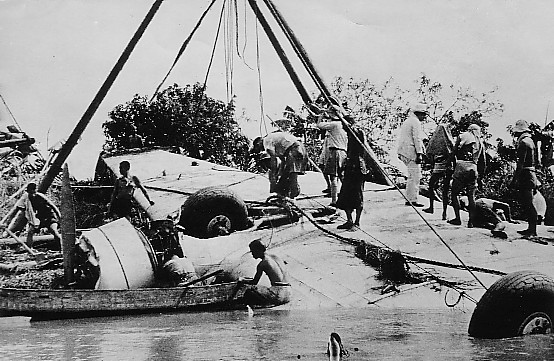|
From The Dragon's Wings "Captain Hugh Woods took off from Hong Kong's Kai Tak airport shortly after 8 A.M., August 24, 1938, for Chungking in a DC-2 named Kweilin. He carried a full load of fourteen passengers. A few minutes after crossing the boundary of the Colony, while climbing through 6,000 feet on a course of 297°, Woods sighted eight aircraft ahead and above. Woods had run into similar flights of Japanese military aircraft on previous occasions, and he was not unduly concerned. CNAC was again a purely commercial company, and the Japanese seemed prepared to return to the status quo ante bellum and treat the airline as a non-belligerent. The DC-2 had an unmistakable silhouette; Kweilin had "CNAC" painted in large black letters on the upper and lower surfaces of the wings and the Chinese characters for mail on the fuselage. Although Woods did not expect trouble, just to be safe he turned back toward the border of British territory. After the Japanese planes disappeared, Woods resumed his original course. As he reached the western end of the bay between the territory of Hong Kong and the Chinese mainland, north of Macao, five Nakajima pursuit planes swooped down on Kweilin. Woods put the DC-2 into a steep dive and headed for a small patch of clouds some 5,000 feet below and to the left. Unfortunately, the clouds covered the tops of several small mountains. "I went to the edge of these clouds." Woods noted in his report of the incident, "and was in there for a few seconds and emerged on the other side. Directly ahead of me all was clear, so I started to turn to re-enter the clouds when I heard machine-gun bullets striking inside the control room. I immediately started descending in a tight spiral. During this spiral I could see the shadow of my plane, also the shadow of another plane directly at my rear. The terrain immediately underneath consisted of small rice paddy fields surrounded by dykes. I considered it extremely hazardous to attempt a landing on land due to these dykes, so I headed for a river a short distance to my right. I shut off the engines, cut the motor switches, and disconnected the battery, and glided into a landing on the water. During this time the plane was being struck by machine-gun bullets. The plane was landed safely near the right-hand side of the river. By the time the water cleared from the windshield, however, the current had caught the 'plane, and swept it into the middle of the current." Woods found that none of the passengers had been injured. He raised the emergency hatch cover in front of the cockpit and looked skyward as Japanese aircraft came down to strafe the crippled Kweilin. Woods ordered the copilot and radio operator to get the passengers into the water. Then he jumped into the river and began to swim toward a sampan, tied up on the shore opposite the aircraft. He continued: It was not until after I started swimming that I noticed the current was so strong. I estimated it later about four or five knots. As I was progressing toward shore several Japanese 'planes dived on me and machine-gunned me. At first I submerged myself when they started shooting, but later became so exhausted I could not do this. Many bullets came extremely close; so close in fact that it left no doubt as to whether they were aiming at me or the ship. After what seemed an endless time, I reached the shore in a state of complete exhaustion....It was probably over an hour before I could stand. I was violently ill at my stomach." Meanwhile, the DC-2 half-submerged, floated downstream. Japanese fighter planes continued their attack. Only two people survived besides Woods: the radio operator (Joe Loh) and an official of the Ministry of finance (Mr. Li Chai-sung). Fourteen died, including Wong Yu-mei of the Central Bank of China, Dr. Liu Chung-chieh, former minister to Berlin, two women, and two children. Nine of the bodies bore machine-gun bullet wounds. CNAC had the dubious distinction of losing the first commercial airliner in the history of aviation to hostile aerial attack. Although later denied by the Japanese, there seems little doubt that the attack had been premeditated." (Note: The Co-Pilot was Lieu Chung-chuan (spelling from a letter from Mrs. Lieu), but from the China Weekly Review, 24 November 1938, the spelling is "Liu Chung-chan".   (Photo courtesy of Tom Moore) The surviving crew and passenger were: 1. Capatin Hugh Woods 2. Radio Operator Joe Loh 3. Mr. Li Chai-sung, official of the Ministry of Finance Two crew and thirteen passengers killed: 1. Co-Pilot Lieu Chung-chuan 2. Mr. Wu Ching-hua, Steward 3. Wong Yu-mei, Chief of ????secretary of the Central Bank of China 4. Dr. Liu Chung-chieh, former minister to Berlin 5. Mr. Loh Yi, instructor at the Berlin University 6. Mrs Hsu Un-yuan 7. Mrs. Li Chai-sung, age 24, and I think her unborn baby 8. Sidney Yang, 29 9, Mrs. Yang (Sidney's wife), age 23 10. Mr. Hu Pei-kong, age 58 11. Master Henry Chung 12. Master Li Teh-lin 13. Mr. Hsu Sing-loh, age 49 14. Mr. Wang Wen-lung 15. Mr. Chen Chien-fei, age 38  or would like to be added to the CNAC e-mail distribution list, please let the CNAC Web Editor, Tom Moore, know. Thanks! |